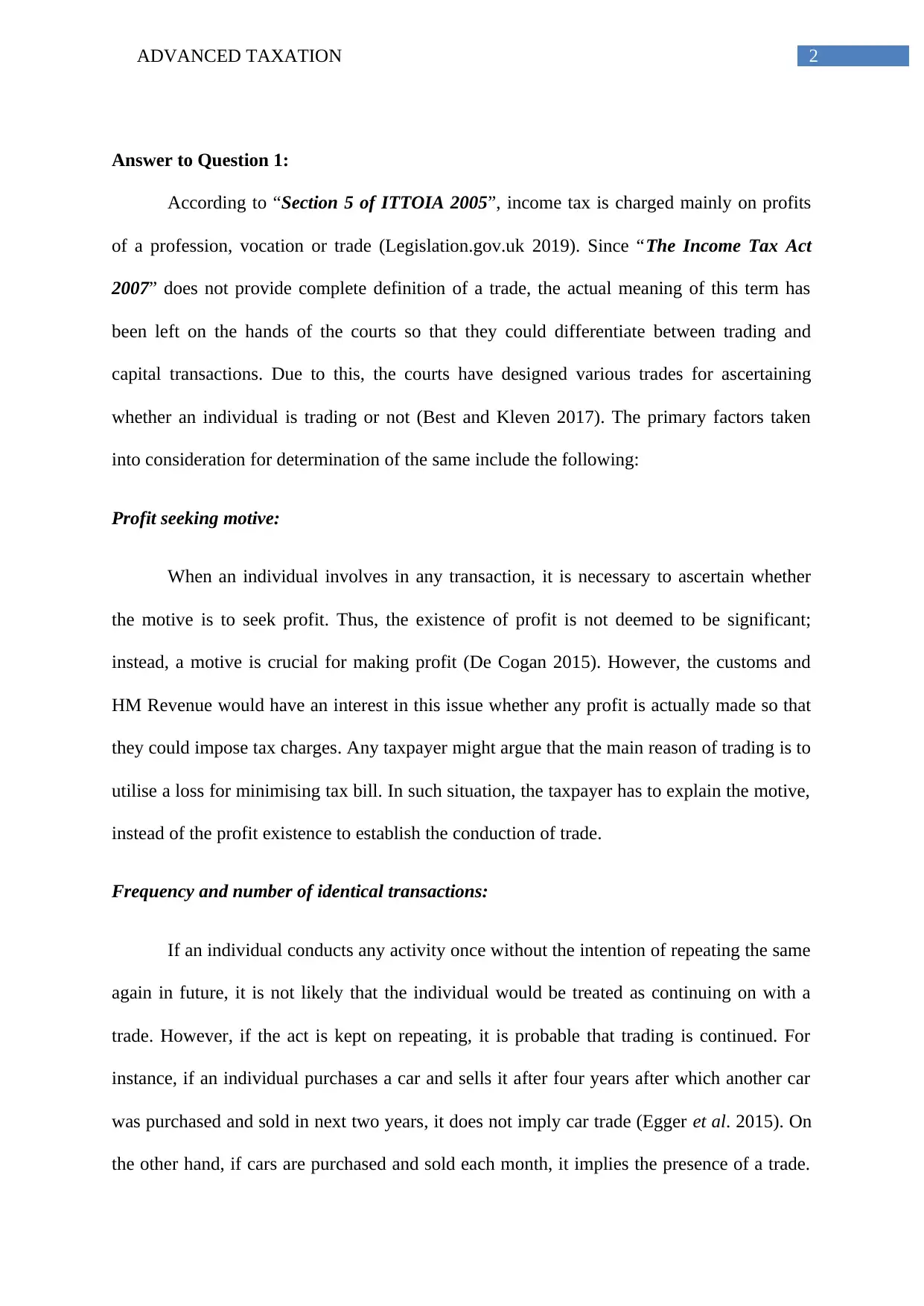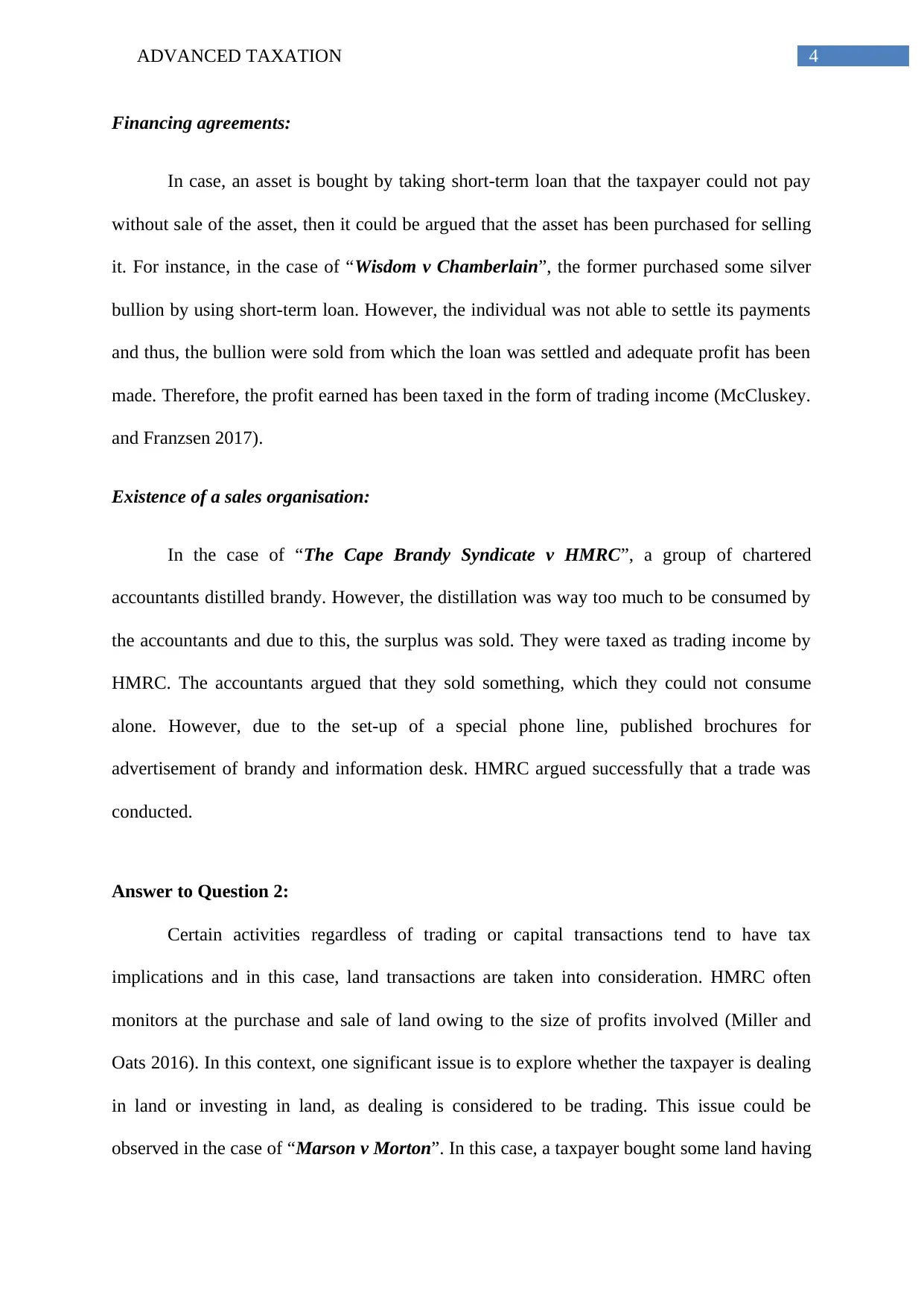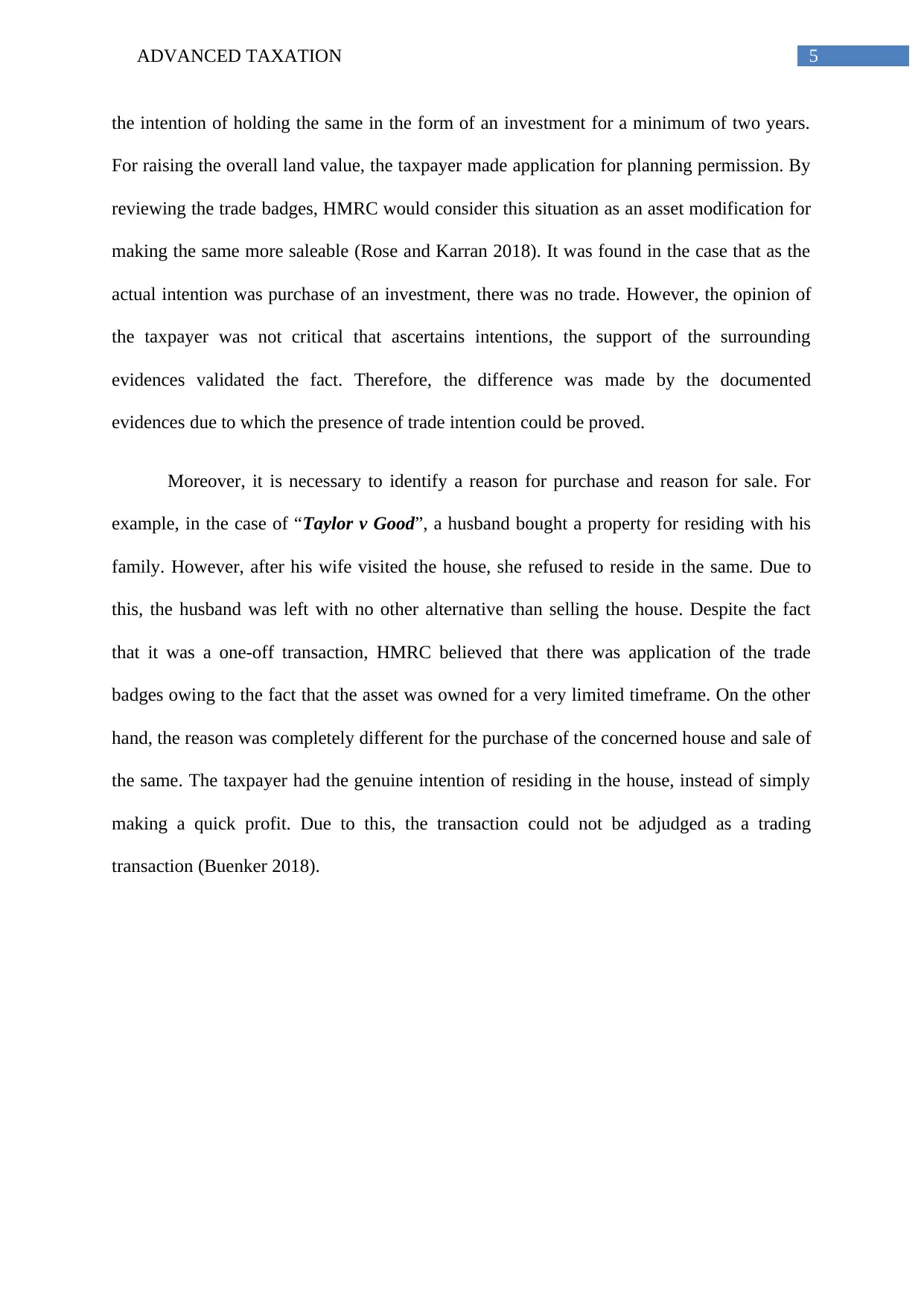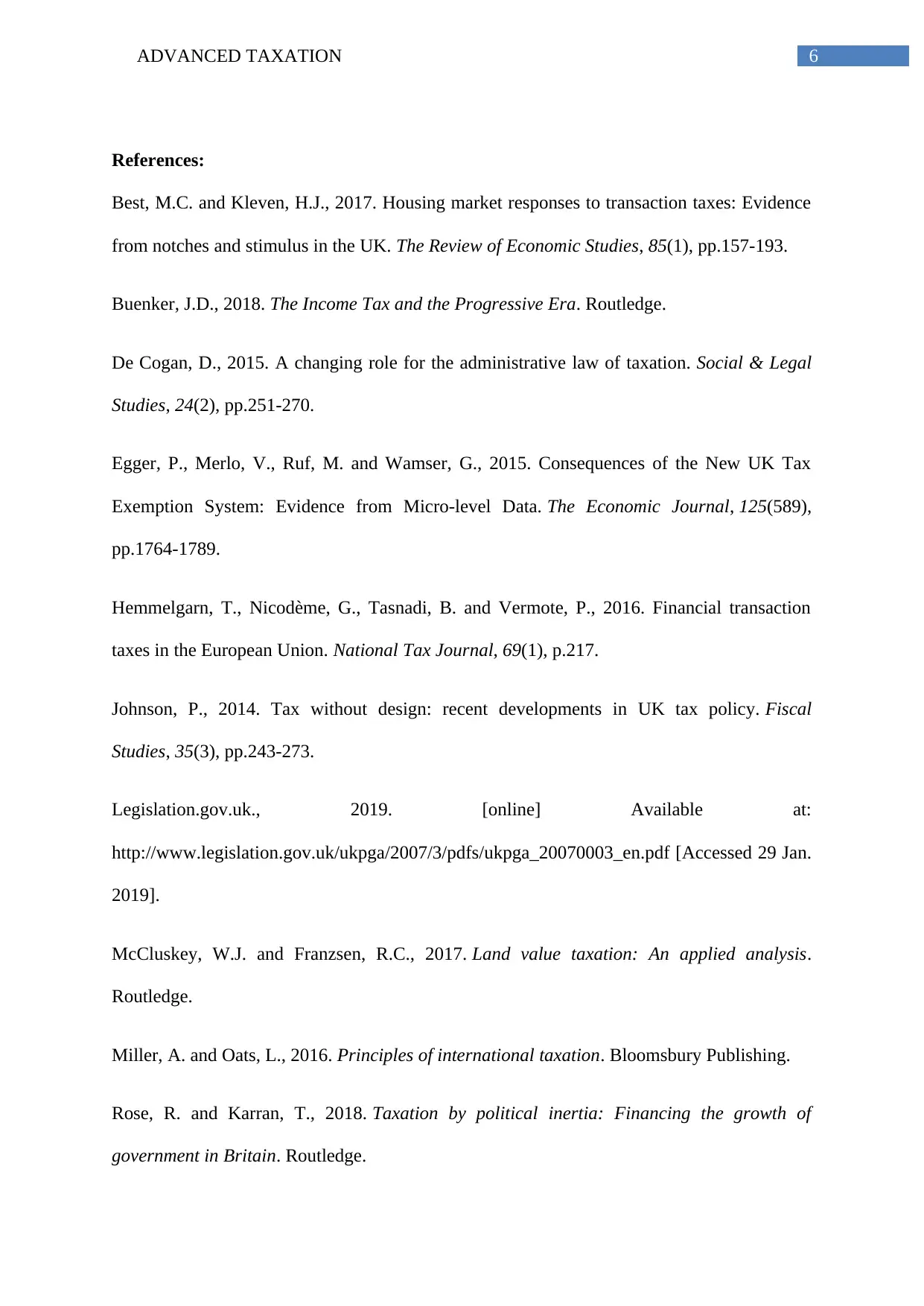Advanced Taxation
VerifiedAdded on 2023/04/25
|8
|1717
|240
AI Summary
This document discusses income tax and land transactions in Advanced Taxation. It provides answers to questions related to trading and capital transactions. The document also includes case studies and references for further reading.
Contribute Materials
Your contribution can guide someone’s learning journey. Share your
documents today.

Running head: ADVANCED TAXATION
Advanced Taxation
Name of the Student:
Name of the University:
Author’s Note:
Course ID:
Advanced Taxation
Name of the Student:
Name of the University:
Author’s Note:
Course ID:
Secure Best Marks with AI Grader
Need help grading? Try our AI Grader for instant feedback on your assignments.

1ADVANCED TAXATION
Table of Contents
Answer to Question 1:................................................................................................................2
Answer to Question 2:................................................................................................................4
References:.................................................................................................................................6
Table of Contents
Answer to Question 1:................................................................................................................2
Answer to Question 2:................................................................................................................4
References:.................................................................................................................................6

2ADVANCED TAXATION
Answer to Question 1:
According to “Section 5 of ITTOIA 2005”, income tax is charged mainly on profits
of a profession, vocation or trade (Legislation.gov.uk 2019). Since “The Income Tax Act
2007” does not provide complete definition of a trade, the actual meaning of this term has
been left on the hands of the courts so that they could differentiate between trading and
capital transactions. Due to this, the courts have designed various trades for ascertaining
whether an individual is trading or not (Best and Kleven 2017). The primary factors taken
into consideration for determination of the same include the following:
Profit seeking motive:
When an individual involves in any transaction, it is necessary to ascertain whether
the motive is to seek profit. Thus, the existence of profit is not deemed to be significant;
instead, a motive is crucial for making profit (De Cogan 2015). However, the customs and
HM Revenue would have an interest in this issue whether any profit is actually made so that
they could impose tax charges. Any taxpayer might argue that the main reason of trading is to
utilise a loss for minimising tax bill. In such situation, the taxpayer has to explain the motive,
instead of the profit existence to establish the conduction of trade.
Frequency and number of identical transactions:
If an individual conducts any activity once without the intention of repeating the same
again in future, it is not likely that the individual would be treated as continuing on with a
trade. However, if the act is kept on repeating, it is probable that trading is continued. For
instance, if an individual purchases a car and sells it after four years after which another car
was purchased and sold in next two years, it does not imply car trade (Egger et al. 2015). On
the other hand, if cars are purchased and sold each month, it implies the presence of a trade.
Answer to Question 1:
According to “Section 5 of ITTOIA 2005”, income tax is charged mainly on profits
of a profession, vocation or trade (Legislation.gov.uk 2019). Since “The Income Tax Act
2007” does not provide complete definition of a trade, the actual meaning of this term has
been left on the hands of the courts so that they could differentiate between trading and
capital transactions. Due to this, the courts have designed various trades for ascertaining
whether an individual is trading or not (Best and Kleven 2017). The primary factors taken
into consideration for determination of the same include the following:
Profit seeking motive:
When an individual involves in any transaction, it is necessary to ascertain whether
the motive is to seek profit. Thus, the existence of profit is not deemed to be significant;
instead, a motive is crucial for making profit (De Cogan 2015). However, the customs and
HM Revenue would have an interest in this issue whether any profit is actually made so that
they could impose tax charges. Any taxpayer might argue that the main reason of trading is to
utilise a loss for minimising tax bill. In such situation, the taxpayer has to explain the motive,
instead of the profit existence to establish the conduction of trade.
Frequency and number of identical transactions:
If an individual conducts any activity once without the intention of repeating the same
again in future, it is not likely that the individual would be treated as continuing on with a
trade. However, if the act is kept on repeating, it is probable that trading is continued. For
instance, if an individual purchases a car and sells it after four years after which another car
was purchased and sold in next two years, it does not imply car trade (Egger et al. 2015). On
the other hand, if cars are purchased and sold each month, it implies the presence of a trade.

3ADVANCED TAXATION
For example, in the case of “Pickford v Quirke”, a taxpayer bought a mill with the intention
of using the same for trading. However, the mill was found to be in a poor state due to which
the buyer had to strip out all items out and sell the same as piecemeal. By conducting the
same, the taxpayer made adequate profit due to which the process was kept on repeating. Due
to such repetition, the profits were classified as taxable under trading income.
Asset modification for making the same more saleable:
If an item is bought, no modifications are made in it and the same is sold, it does not
denote the presence of trading. However, if the car is purchased and modifications like
putting a new engine and re-spraying the body for increasing its attractiveness are made, it is
possible that the individual is deemed to be trading (Hemmelgarn et al. 2016).
Nature of the asset:
A trading label could be pinned on a single one-off transaction, since justification
could not be provided that the specific asset was bought for other purpose than resale. For
example, in the case of “Rutledge v CIR”, a taxpayer bought 1 million rolls of toilet papers in
a single transaction, which were sold later in a single transaction as well. This could be
identified as trading due to the absence of any justified reason for such big purchase, since
overstocking could not be presented as a reason.
Connection with a current trade:
It is assumed that an individual as a tax consultant has sold a car. It is not likely that
the individual would be involved in car trading due to the absence of any direct connection
between a tax professional and selling car (Johnson 2014). However, if the individual is a car
mechanic occasionally engaged in selling a car, the individual would have to bear the tax on
profits on car sales due to the direct link between the profession and selling car.
For example, in the case of “Pickford v Quirke”, a taxpayer bought a mill with the intention
of using the same for trading. However, the mill was found to be in a poor state due to which
the buyer had to strip out all items out and sell the same as piecemeal. By conducting the
same, the taxpayer made adequate profit due to which the process was kept on repeating. Due
to such repetition, the profits were classified as taxable under trading income.
Asset modification for making the same more saleable:
If an item is bought, no modifications are made in it and the same is sold, it does not
denote the presence of trading. However, if the car is purchased and modifications like
putting a new engine and re-spraying the body for increasing its attractiveness are made, it is
possible that the individual is deemed to be trading (Hemmelgarn et al. 2016).
Nature of the asset:
A trading label could be pinned on a single one-off transaction, since justification
could not be provided that the specific asset was bought for other purpose than resale. For
example, in the case of “Rutledge v CIR”, a taxpayer bought 1 million rolls of toilet papers in
a single transaction, which were sold later in a single transaction as well. This could be
identified as trading due to the absence of any justified reason for such big purchase, since
overstocking could not be presented as a reason.
Connection with a current trade:
It is assumed that an individual as a tax consultant has sold a car. It is not likely that
the individual would be involved in car trading due to the absence of any direct connection
between a tax professional and selling car (Johnson 2014). However, if the individual is a car
mechanic occasionally engaged in selling a car, the individual would have to bear the tax on
profits on car sales due to the direct link between the profession and selling car.
Secure Best Marks with AI Grader
Need help grading? Try our AI Grader for instant feedback on your assignments.

4ADVANCED TAXATION
Financing agreements:
In case, an asset is bought by taking short-term loan that the taxpayer could not pay
without sale of the asset, then it could be argued that the asset has been purchased for selling
it. For instance, in the case of “Wisdom v Chamberlain”, the former purchased some silver
bullion by using short-term loan. However, the individual was not able to settle its payments
and thus, the bullion were sold from which the loan was settled and adequate profit has been
made. Therefore, the profit earned has been taxed in the form of trading income (McCluskey.
and Franzsen 2017).
Existence of a sales organisation:
In the case of “The Cape Brandy Syndicate v HMRC”, a group of chartered
accountants distilled brandy. However, the distillation was way too much to be consumed by
the accountants and due to this, the surplus was sold. They were taxed as trading income by
HMRC. The accountants argued that they sold something, which they could not consume
alone. However, due to the set-up of a special phone line, published brochures for
advertisement of brandy and information desk. HMRC argued successfully that a trade was
conducted.
Answer to Question 2:
Certain activities regardless of trading or capital transactions tend to have tax
implications and in this case, land transactions are taken into consideration. HMRC often
monitors at the purchase and sale of land owing to the size of profits involved (Miller and
Oats 2016). In this context, one significant issue is to explore whether the taxpayer is dealing
in land or investing in land, as dealing is considered to be trading. This issue could be
observed in the case of “Marson v Morton”. In this case, a taxpayer bought some land having
Financing agreements:
In case, an asset is bought by taking short-term loan that the taxpayer could not pay
without sale of the asset, then it could be argued that the asset has been purchased for selling
it. For instance, in the case of “Wisdom v Chamberlain”, the former purchased some silver
bullion by using short-term loan. However, the individual was not able to settle its payments
and thus, the bullion were sold from which the loan was settled and adequate profit has been
made. Therefore, the profit earned has been taxed in the form of trading income (McCluskey.
and Franzsen 2017).
Existence of a sales organisation:
In the case of “The Cape Brandy Syndicate v HMRC”, a group of chartered
accountants distilled brandy. However, the distillation was way too much to be consumed by
the accountants and due to this, the surplus was sold. They were taxed as trading income by
HMRC. The accountants argued that they sold something, which they could not consume
alone. However, due to the set-up of a special phone line, published brochures for
advertisement of brandy and information desk. HMRC argued successfully that a trade was
conducted.
Answer to Question 2:
Certain activities regardless of trading or capital transactions tend to have tax
implications and in this case, land transactions are taken into consideration. HMRC often
monitors at the purchase and sale of land owing to the size of profits involved (Miller and
Oats 2016). In this context, one significant issue is to explore whether the taxpayer is dealing
in land or investing in land, as dealing is considered to be trading. This issue could be
observed in the case of “Marson v Morton”. In this case, a taxpayer bought some land having

5ADVANCED TAXATION
the intention of holding the same in the form of an investment for a minimum of two years.
For raising the overall land value, the taxpayer made application for planning permission. By
reviewing the trade badges, HMRC would consider this situation as an asset modification for
making the same more saleable (Rose and Karran 2018). It was found in the case that as the
actual intention was purchase of an investment, there was no trade. However, the opinion of
the taxpayer was not critical that ascertains intentions, the support of the surrounding
evidences validated the fact. Therefore, the difference was made by the documented
evidences due to which the presence of trade intention could be proved.
Moreover, it is necessary to identify a reason for purchase and reason for sale. For
example, in the case of “Taylor v Good”, a husband bought a property for residing with his
family. However, after his wife visited the house, she refused to reside in the same. Due to
this, the husband was left with no other alternative than selling the house. Despite the fact
that it was a one-off transaction, HMRC believed that there was application of the trade
badges owing to the fact that the asset was owned for a very limited timeframe. On the other
hand, the reason was completely different for the purchase of the concerned house and sale of
the same. The taxpayer had the genuine intention of residing in the house, instead of simply
making a quick profit. Due to this, the transaction could not be adjudged as a trading
transaction (Buenker 2018).
the intention of holding the same in the form of an investment for a minimum of two years.
For raising the overall land value, the taxpayer made application for planning permission. By
reviewing the trade badges, HMRC would consider this situation as an asset modification for
making the same more saleable (Rose and Karran 2018). It was found in the case that as the
actual intention was purchase of an investment, there was no trade. However, the opinion of
the taxpayer was not critical that ascertains intentions, the support of the surrounding
evidences validated the fact. Therefore, the difference was made by the documented
evidences due to which the presence of trade intention could be proved.
Moreover, it is necessary to identify a reason for purchase and reason for sale. For
example, in the case of “Taylor v Good”, a husband bought a property for residing with his
family. However, after his wife visited the house, she refused to reside in the same. Due to
this, the husband was left with no other alternative than selling the house. Despite the fact
that it was a one-off transaction, HMRC believed that there was application of the trade
badges owing to the fact that the asset was owned for a very limited timeframe. On the other
hand, the reason was completely different for the purchase of the concerned house and sale of
the same. The taxpayer had the genuine intention of residing in the house, instead of simply
making a quick profit. Due to this, the transaction could not be adjudged as a trading
transaction (Buenker 2018).

6ADVANCED TAXATION
References:
Best, M.C. and Kleven, H.J., 2017. Housing market responses to transaction taxes: Evidence
from notches and stimulus in the UK. The Review of Economic Studies, 85(1), pp.157-193.
Buenker, J.D., 2018. The Income Tax and the Progressive Era. Routledge.
De Cogan, D., 2015. A changing role for the administrative law of taxation. Social & Legal
Studies, 24(2), pp.251-270.
Egger, P., Merlo, V., Ruf, M. and Wamser, G., 2015. Consequences of the New UK Tax
Exemption System: Evidence from Micro‐level Data. The Economic Journal, 125(589),
pp.1764-1789.
Hemmelgarn, T., Nicodème, G., Tasnadi, B. and Vermote, P., 2016. Financial transaction
taxes in the European Union. National Tax Journal, 69(1), p.217.
Johnson, P., 2014. Tax without design: recent developments in UK tax policy. Fiscal
Studies, 35(3), pp.243-273.
Legislation.gov.uk., 2019. [online] Available at:
http://www.legislation.gov.uk/ukpga/2007/3/pdfs/ukpga_20070003_en.pdf [Accessed 29 Jan.
2019].
McCluskey, W.J. and Franzsen, R.C., 2017. Land value taxation: An applied analysis.
Routledge.
Miller, A. and Oats, L., 2016. Principles of international taxation. Bloomsbury Publishing.
Rose, R. and Karran, T., 2018. Taxation by political inertia: Financing the growth of
government in Britain. Routledge.
References:
Best, M.C. and Kleven, H.J., 2017. Housing market responses to transaction taxes: Evidence
from notches and stimulus in the UK. The Review of Economic Studies, 85(1), pp.157-193.
Buenker, J.D., 2018. The Income Tax and the Progressive Era. Routledge.
De Cogan, D., 2015. A changing role for the administrative law of taxation. Social & Legal
Studies, 24(2), pp.251-270.
Egger, P., Merlo, V., Ruf, M. and Wamser, G., 2015. Consequences of the New UK Tax
Exemption System: Evidence from Micro‐level Data. The Economic Journal, 125(589),
pp.1764-1789.
Hemmelgarn, T., Nicodème, G., Tasnadi, B. and Vermote, P., 2016. Financial transaction
taxes in the European Union. National Tax Journal, 69(1), p.217.
Johnson, P., 2014. Tax without design: recent developments in UK tax policy. Fiscal
Studies, 35(3), pp.243-273.
Legislation.gov.uk., 2019. [online] Available at:
http://www.legislation.gov.uk/ukpga/2007/3/pdfs/ukpga_20070003_en.pdf [Accessed 29 Jan.
2019].
McCluskey, W.J. and Franzsen, R.C., 2017. Land value taxation: An applied analysis.
Routledge.
Miller, A. and Oats, L., 2016. Principles of international taxation. Bloomsbury Publishing.
Rose, R. and Karran, T., 2018. Taxation by political inertia: Financing the growth of
government in Britain. Routledge.
Paraphrase This Document
Need a fresh take? Get an instant paraphrase of this document with our AI Paraphraser

7ADVANCED TAXATION
1 out of 8
Related Documents
Your All-in-One AI-Powered Toolkit for Academic Success.
+13062052269
info@desklib.com
Available 24*7 on WhatsApp / Email
![[object Object]](/_next/static/media/star-bottom.7253800d.svg)
Unlock your academic potential
© 2024 | Zucol Services PVT LTD | All rights reserved.





